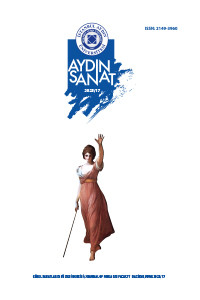The Recent History of Digital Creativity Through the Lens of User Experience Design and What It Says to Today's Design Environment
Öz
Digital creativity or machine creativity, in other words, has been classified among technological and scientific developments since the 50s, when the first examples emerged, and has played an important role in the development of many innovative software and expression forms. However, in recent years, with the rapid democratization of artificial intelligence technologies, and thus machine learning tools finding their place in the art and design environment, these technological developments have also started to become a subject of discussion in the creative industry.
The aim of the research is to examine the technological advances of recent history in the context of these developments with the perspective of today's experience design approach and to trace these current debates retrospectively. In line with this aim, the study analyzes important developments in the recent past of digital creativity and discusses its organic relations with today's design environment.
Anahtar Kelimeler
Kullanıcı Deneyimi Tasarımı Makine Yaratıcılığı Yapay Zekâ Sayısal Yaratıcılık Yeni medya
Kaynakça
- Asaro, P. M. (2010). What ever happened to cybernetics? https://peterasaro.org/writing/What%20happened%20to%20cybernetics.pdf (01.12.2022).
- Bayrak, Y. (2018). Yapay zekâ çıkınca UX bitecek mi? Sherpa.Blog. https://sherpa.blog/ai-yapay-zeka-cikinca-uxbitecekmi?wv_email=ziyacan bayar@gmail.com&utm_source=SHERPA+Blog&utm_campaign=e290a9282aRichDigest_COPY_01&utm_medium=email&utm_term=0_a491421608-e290a9282a-125338233 (07.11.2018).
- Engelbart, D. (1962). Doug Engelbart Institue, Augmenting Human Intellect: A Conceptual Framework, https://www.dougengelbart.org/pubs/augment-3906.html (09.13.2017).
- Fred, T. (2006). From Counterculture to Cyberculture Stewart Brand, the Whole Earth Network, and the Rise of Digital Utopianism. The University of Chicago Press. s: 56-58 Hurme, P. T., & Jouhki, J. (2017). We Shape Our Tools, and Thereafter Our Tools Shape Us Pertti T Hurme Jukka Jouhki. Human Technology, 13(2): 145-148.
- Kuchukov, R. (2021). NeuroArch: Architectural Imagery of Artificial Intelligence https://towardsdatascience.com/neuroarch-ai-imagery-eng-1b9e1d11944a (5.11.2022).
- Mandelbrot, B. (2010). Benoit Mandelbrot: Fraktallar ve Pürüz Sanatı. TED, Ideas Worth Spreading, 2018: https://www.ted.com/talks/benoit_mandelbrot_fractals_the_art_of_roughness?language=tr (26.01.2018). Memex Explained: Everything You Need to Know. (2021).
- History-Computer: https://history-computer.com/memex-guide/ (10.12.2021).
- Oktan, S., & Vural, S. (2017). Parametricism: Astyle or method? Archtheo '17 / Xi. Theory And Histroy Of Architecture Conference, İstanbul.
- Pannafino, J. (2017). Paylaşılan Meslek. Grafik sanatlar Üzerine Yazılar(180), s: 3-4.
- Pattison, Y. (t.y.). Cybernetic Serendipity Archive.
- Cybernetic Serendipity: http://www.cyberneticserendipity.net (01.02.2017).
- Perry, T., & Paul, W. (t.y) Xerox Parc’s Engineers on How They Invented the Future https://spectrum.ieee.org/xerox-parc#toggle-gdpr (05.12.2022).
- Pieters, R., & Winiger, S. (2016). Creative AI, On the democratisation & Escalation of Creativity.Medium, https://medium.com/@creativeai/creativeai9d4b2346fa f#63b1 (13.09.2017).
- Shneiderman, B. (2000, 03). Creating Creativity: User Interfaces for Supporting Innovation. ACM Transactions on Computer-Human Interaction, 7(1):114-138.
- Sutherland, I. E. (2003). Sketchpad: A man-machine graphical communication system. University of Cambridge, Computer Laboratory. Cambridge: University of Cambridge Computer Laboratory Technical Report 574.
- Tresler, M. (2014). Experience Design is shaping our future.
- O'Reilly Media: https://www.oreilly.com/ideas/experience-design-iot-design-business-design (24.07.2017).
- Vetrov, Y. (2017). Algorithm-Driven Design: How Artificial Intelligence is Changing Design. Smashing Magazine: https://www.smashingmagazine.com/2017/01/algorithm-driven-design-how-artificial-intelligence-changing-design/ (20.09.2017).
Öz
Sayısal yaratıcılık ya da diğer adıyla makine yaratıcılığı ilk örneklerinin ortaya çıktığı 50’li yıllardan yakın geçmişe dek teknolojik ve bilimsel gelişmeler arasında sınıflandırılmış, pek çok yenilikçi yazılım ve ifade biçiminin geliştirilmesinde önemli bir dayanak görevi üstlenmiştir. Fakat son yıllarda yapay zekâ teknolojilerinin büyük bir hızla yayılması ve demokratikleşmesi, makine öğrenmesi araçlarının sanat ve tasarım ortamında kendine sıklıkla yer bulmasını beraberinde getirmiştir. Bu teknolojik gelişmeler aynı zamanda yaratıcı endüstrinin de tartışma konusu haline gelmeye başlamıştır.
Araştırmanın amacı bu gelişmeler bağlamında yakın tarihin teknolojik ilerlemelerini bugünün deneyim tasarımı yaklaşımı bağlamında irdelemek ve bu güncel tartışmaların geçmişe dönük izini sürmektir. Bu amaca ulaşma doğrultusunda çalışma sayısal yaratıcılığın yakın geçmişindeki önemli gelişmeleri literatür taraması metoduyla analiz edilmekte ve bugünün tasarım ortamı ile organik ilişkilerini tartışmaktadır. Elde ettiği bulgular ile çalışma güncel tasarım ortamında yaratıcı bireyin kendini tanımlaması ve konumlandırması üzerine güncel sorulara yanıt olunması hedeflenmektedir.
Anahtar Kelimeler
Kullanıcı Deneyimi Tasarımı Makine Yaratıcılığı Yapay Zekâ Sayısal Yaratıcılık Yeni medya
Kaynakça
- Asaro, P. M. (2010). What ever happened to cybernetics? https://peterasaro.org/writing/What%20happened%20to%20cybernetics.pdf (01.12.2022).
- Bayrak, Y. (2018). Yapay zekâ çıkınca UX bitecek mi? Sherpa.Blog. https://sherpa.blog/ai-yapay-zeka-cikinca-uxbitecekmi?wv_email=ziyacan bayar@gmail.com&utm_source=SHERPA+Blog&utm_campaign=e290a9282aRichDigest_COPY_01&utm_medium=email&utm_term=0_a491421608-e290a9282a-125338233 (07.11.2018).
- Engelbart, D. (1962). Doug Engelbart Institue, Augmenting Human Intellect: A Conceptual Framework, https://www.dougengelbart.org/pubs/augment-3906.html (09.13.2017).
- Fred, T. (2006). From Counterculture to Cyberculture Stewart Brand, the Whole Earth Network, and the Rise of Digital Utopianism. The University of Chicago Press. s: 56-58 Hurme, P. T., & Jouhki, J. (2017). We Shape Our Tools, and Thereafter Our Tools Shape Us Pertti T Hurme Jukka Jouhki. Human Technology, 13(2): 145-148.
- Kuchukov, R. (2021). NeuroArch: Architectural Imagery of Artificial Intelligence https://towardsdatascience.com/neuroarch-ai-imagery-eng-1b9e1d11944a (5.11.2022).
- Mandelbrot, B. (2010). Benoit Mandelbrot: Fraktallar ve Pürüz Sanatı. TED, Ideas Worth Spreading, 2018: https://www.ted.com/talks/benoit_mandelbrot_fractals_the_art_of_roughness?language=tr (26.01.2018). Memex Explained: Everything You Need to Know. (2021).
- History-Computer: https://history-computer.com/memex-guide/ (10.12.2021).
- Oktan, S., & Vural, S. (2017). Parametricism: Astyle or method? Archtheo '17 / Xi. Theory And Histroy Of Architecture Conference, İstanbul.
- Pannafino, J. (2017). Paylaşılan Meslek. Grafik sanatlar Üzerine Yazılar(180), s: 3-4.
- Pattison, Y. (t.y.). Cybernetic Serendipity Archive.
- Cybernetic Serendipity: http://www.cyberneticserendipity.net (01.02.2017).
- Perry, T., & Paul, W. (t.y) Xerox Parc’s Engineers on How They Invented the Future https://spectrum.ieee.org/xerox-parc#toggle-gdpr (05.12.2022).
- Pieters, R., & Winiger, S. (2016). Creative AI, On the democratisation & Escalation of Creativity.Medium, https://medium.com/@creativeai/creativeai9d4b2346fa f#63b1 (13.09.2017).
- Shneiderman, B. (2000, 03). Creating Creativity: User Interfaces for Supporting Innovation. ACM Transactions on Computer-Human Interaction, 7(1):114-138.
- Sutherland, I. E. (2003). Sketchpad: A man-machine graphical communication system. University of Cambridge, Computer Laboratory. Cambridge: University of Cambridge Computer Laboratory Technical Report 574.
- Tresler, M. (2014). Experience Design is shaping our future.
- O'Reilly Media: https://www.oreilly.com/ideas/experience-design-iot-design-business-design (24.07.2017).
- Vetrov, Y. (2017). Algorithm-Driven Design: How Artificial Intelligence is Changing Design. Smashing Magazine: https://www.smashingmagazine.com/2017/01/algorithm-driven-design-how-artificial-intelligence-changing-design/ (20.09.2017).
Ayrıntılar
| Birincil Dil | Türkçe |
|---|---|
| Bölüm | Araştırma Makaleleri (Çift kör hakem sürecinden geçmiş ve indekslenebilir makalelerdir) |
| Yazarlar | |
| Yayımlanma Tarihi | 30 Haziran 2023 |
| Gönderilme Tarihi | 14 Aralık 2022 |
| Yayımlandığı Sayı | Yıl 2023 Cilt: 9 Sayı: 17 |
All site content, except where otherwise noted, is licensed under a Creative Common Attribution Licence. (CC-BY-NC 4.0)



